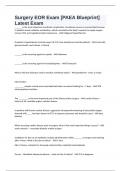Surgery EOR Exam [PAEA Blueprint]
Latest Exam
_______is the most important anesthetic complication. Anesthesia causes an uncontrolled increase
in skeletal muscle oxidative metabolism, which overwhelms the body's capacity to supply oxygen,
remove CO2, and regulative body temperature. - ANS Malignant hyperthermia
If patient is hyperkalemic (normal range 3.8-5.0), how should you treat the patient? - ANS treat with
glucose/insulin, and calcium +/-bicarb
_______is the reversing agent for opiods. - ANS Naloxone
_______is the reversing agent for benzodiazipines. - ANS Flumazenil
What is the best indicator used to monitor nutritional status? - ANS prealbumin - every 2-3 days
Intervention:
_________require central access and indicated when no enteral feeding for > 7 days. - ANS TPN -
total peripheral nutrition
The _________is the most important part of the history before surgery. - ANS cardiac history --
history of MI, unstable angina, valvular disease
In patients with known cardiac disease, aggressive intraoperative lowering of myocardial oxygen
demand with ____ has been shown in RCT's to improve outcomes and should be used. - ANS beta
blockers
When accessing cardiac disease prior to surgery, what is the most important thing to access? - ANS
aortic stenosis -- crescendo diastolic rumble at apex
Guidelines for the use of antibiotics include administration within _______ of surgery and redosing
after 4 hours. What is the abx of choice? - ANS 1 hour
Abx of choice: cefazolin for all except colorectal then cefazolin/metronidazole
Pre-op -- Metabolic disease/syndrome -- what are the 5 criteria? - ANS 3/5 to diagnose:
,1 - diabetes
2 - central obesity
3 - HTN
4 - high serum triglycerrides
5 - low HDL levels
______should be monitored before surgery bc it is a stimulant and vasoconstrictor -- can lead to
severe tachycardia - ANS Cocaine
Pre-Op -- What are the indications for EKG and CXR? - ANS EKG - men >40, women>50, known CAD,
DM, or HTN
CXR - age >50, known cardiac or pulmonary disease
What are the 5 classic "W's" of post operative fever? - ANS W - wind (atelectasis)
W - water (UTI)
W - wound (wound infection)
W - walking (DVT/thrombophlebitis)
W - wonder drugs (drug fever)
If the post op fever occurs within the first 24 hours of surgery, what is the most likely cause? - ANS
wind/atelectasis
If the post op fever occurs within days 3-5 post op, what is the most likely cause? - ANS water/UTI,
catheter related phlebitis, pneumonia
If the post op fever occurs within days 5-10 post op, what is the most likely cause? - ANS wound
infection, pneumonia, abscess, infected hematoma, C diff colitis, anastomotic leak, DVT, peritoneal
abscess, drug fever, PE, parotitis
_______is the most common pathogen in wound infections and around foreign bodies. - ANS Staph
aureus
_______invades the inner ear and enteric tissues as well as the lung. - ANS Klebsiella
,______organisms are often found together with anaerobes. - ANS Enteric organisms ie.
enterobacteriaceae and enterococci
Among the anaerobes, ___&___are often present in surgical infections and _____species are major
pathogens in ischemic tissue. - ANS Bacteroides & Peptostreptococci; Clostridium
___&___are usually nonpathogenic surface contaminants but may be opportunistic.
Some fungi and yeast cause abscesses in sinus tracts. - ANS Pseudomonas & Serratia
History of recent surgery, trauma, cancer, prolonged immobilization, or oral contraceptive use
increases the risk of ____. - ANS DVT - deep vein thrombosis
What is Homan's sign? - ANS pain on passive dorsiflexion of ankle
What is the test of choice for DVT? - ANS doppler ultrasound
How is the D-dimer text useful? - ANS It is good at ruling a DVT out (if the text is negative) but not
rule it in
Tx of DVT --
1. Initiate use of ____or____to what dose?
2. Overlap with the use of ____to what therapeutic range?
3. Why overlap therapies? - ANS DVT
1. Initiate Heparin to PTT of 0.3-0.7 U/mL or LMWH wo monitoring.
2. Overlap with warfarin to INR between 2-3.
3. Overlap therapies to decrease changes of hypercoagulable state.
The most common cause of SIRS (systemic inflammatory response syndrome) is sepsis. What are the
criteria for dx of SIRS? - ANS At least 2 of the following:
1. temp >38C or <36C
2. tachy >90
, 3. tachypnea > 20 breaths/minute
4. PCO2 <32mmHg
5. WBC > 12,000/uL or <4000/uL
After sepsis, what are the next two most common causes of SIRS? - ANS pancreatitis and drugs
What is the difference between hypovolemia and dehydration? - ANS hypovolemia is loss of both
water and sodium while dehydration is loss of intracellular water or deficit with hypernatremia --
dehydration occurs when patient can not adjust water intake for water loss
What are the clinical signs of dehydration and hypovolemia? - ANS tachycardia, hypotension, pale
skin, increased capillary refill time, dizziness, faintness, nausea, thirst, decreased urine output -- in
hypovolemia, urine will demonstrate low sodium concentration
What are 2 common conditions with dehydration? - ANS diabetes insipidus (lack of ADH or unable to
respond to ADH), fever with increased water loss
Hyponatremia Causes
_______ = cirrhosis, CHF, nephrotic syndrome, massive edema
_______=states of severe pain or nausea, trauma, brain damage, SIADH
_______=prolonged vomiting, decreased oral intake, severe diarrhea, diuretic use
Misc causes = factitious hyponatremia, hypothyroidism, adrenal insufficiency, malnourished states,
primary polydipsia - ANS Hypervolemic, Euvolemic, Hypovolemic
What are the two most common treatments for hyponatremia?
Other less common treatment? - ANS salt tabs and fluid restriction; vasopressin receptor antagonist
in SIADH, CHF, and cirrhosis
Hypernatremia is almost always due to _______. Therefore, what is the treatment? - ANS
dehydration; rehydrate!
What s/s can result in a hyperkalemic patient? - ANS cardiac arrhythmias (tall peaked T waves) and
weakness




